MBA Analysis: Indo-Western Brands' International Expansion Challenges
VerifiedAdded on 2023/04/24
|42
|12262
|425
Report
AI Summary
This MBA report provides a comprehensive analysis of the challenges and factors affecting the expansion of Indo-Western brands into Western markets. The study investigates the concept of international market expansion, highlighting the difficulties these brands face. It examines key factors such as cultural differences, market strategies, and consumer behavior. The research employs a non-probability purposive sampling questionnaire to identify crucial elements for success in the Western market. The report also includes a literature review, research methodology, key findings, and a conclusion with recommendations for Indo-Western brands aiming for international growth. The report emphasizes the importance of adapting business models and understanding evolving market dynamics. A website has also been created to support the research, and the link has been included at the end of the research.
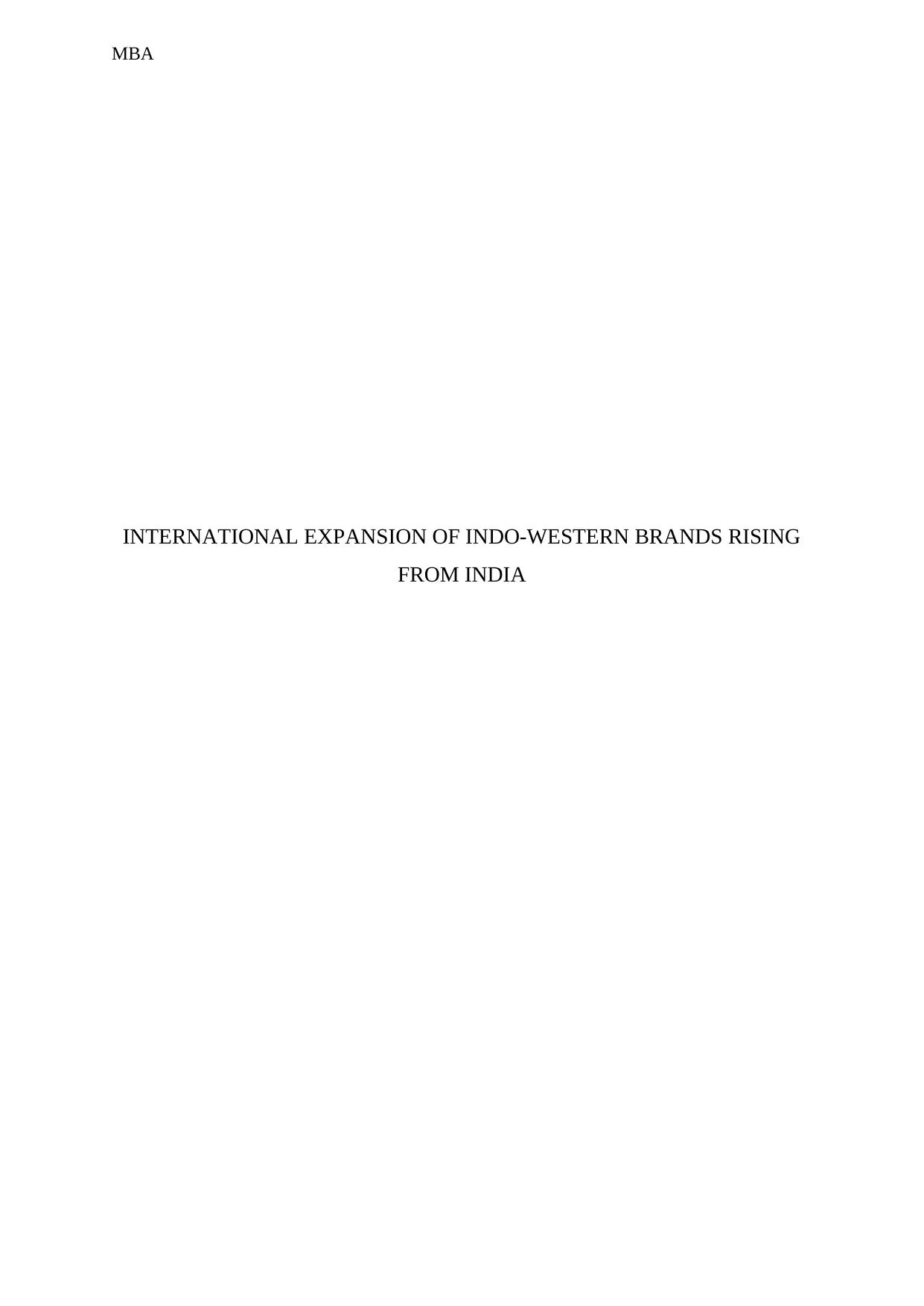
MBA
INTERNATIONAL EXPANSION OF INDO-WESTERN BRANDS RISING
FROM INDIA
INTERNATIONAL EXPANSION OF INDO-WESTERN BRANDS RISING
FROM INDIA
Paraphrase This Document
Need a fresh take? Get an instant paraphrase of this document with our AI Paraphraser
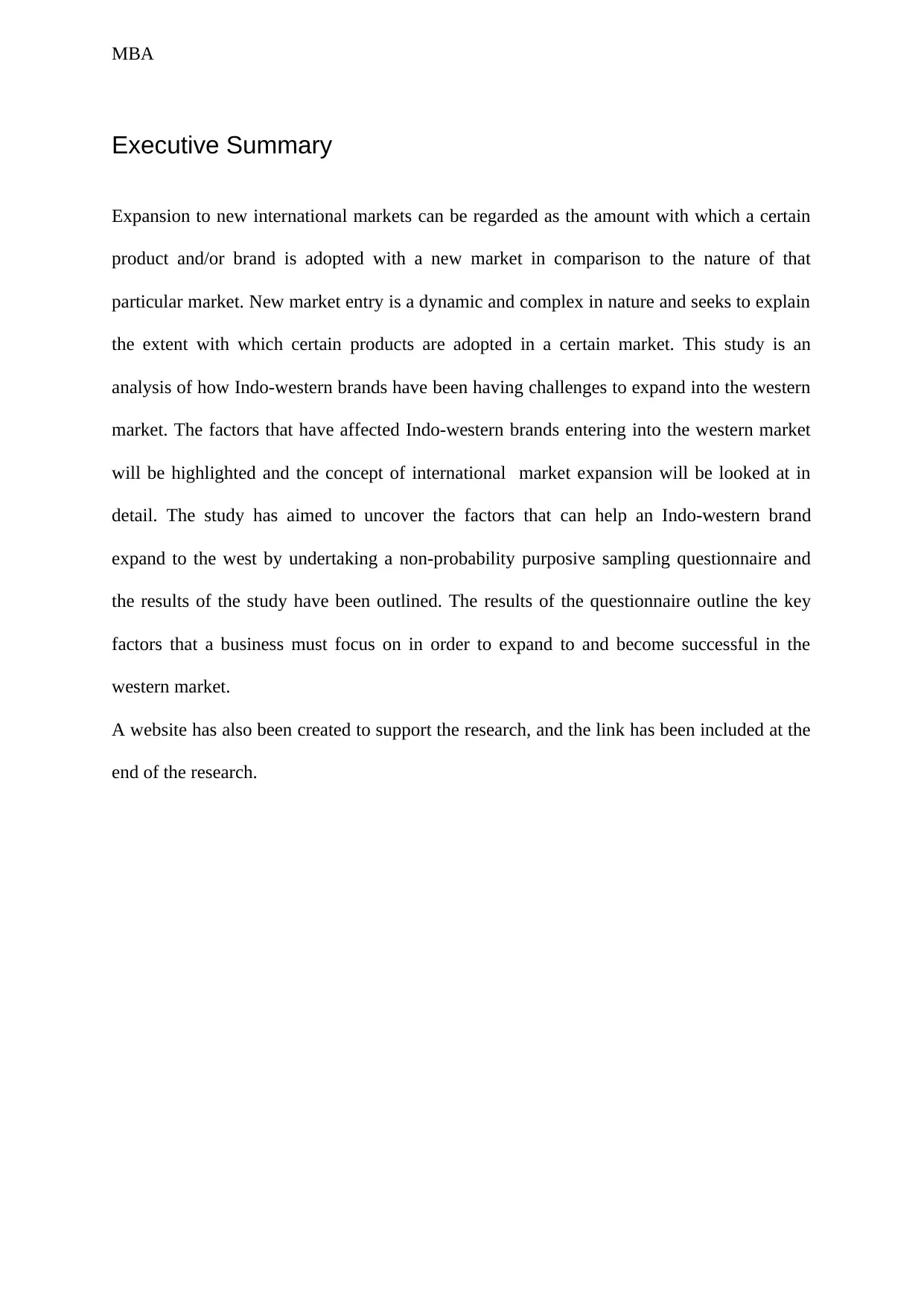
MBA
Executive Summary
Expansion to new international markets can be regarded as the amount with which a certain
product and/or brand is adopted with a new market in comparison to the nature of that
particular market. New market entry is a dynamic and complex in nature and seeks to explain
the extent with which certain products are adopted in a certain market. This study is an
analysis of how Indo-western brands have been having challenges to expand into the western
market. The factors that have affected Indo-western brands entering into the western market
will be highlighted and the concept of international market expansion will be looked at in
detail. The study has aimed to uncover the factors that can help an Indo-western brand
expand to the west by undertaking a non-probability purposive sampling questionnaire and
the results of the study have been outlined. The results of the questionnaire outline the key
factors that a business must focus on in order to expand to and become successful in the
western market.
A website has also been created to support the research, and the link has been included at the
end of the research.
Executive Summary
Expansion to new international markets can be regarded as the amount with which a certain
product and/or brand is adopted with a new market in comparison to the nature of that
particular market. New market entry is a dynamic and complex in nature and seeks to explain
the extent with which certain products are adopted in a certain market. This study is an
analysis of how Indo-western brands have been having challenges to expand into the western
market. The factors that have affected Indo-western brands entering into the western market
will be highlighted and the concept of international market expansion will be looked at in
detail. The study has aimed to uncover the factors that can help an Indo-western brand
expand to the west by undertaking a non-probability purposive sampling questionnaire and
the results of the study have been outlined. The results of the questionnaire outline the key
factors that a business must focus on in order to expand to and become successful in the
western market.
A website has also been created to support the research, and the link has been included at the
end of the research.
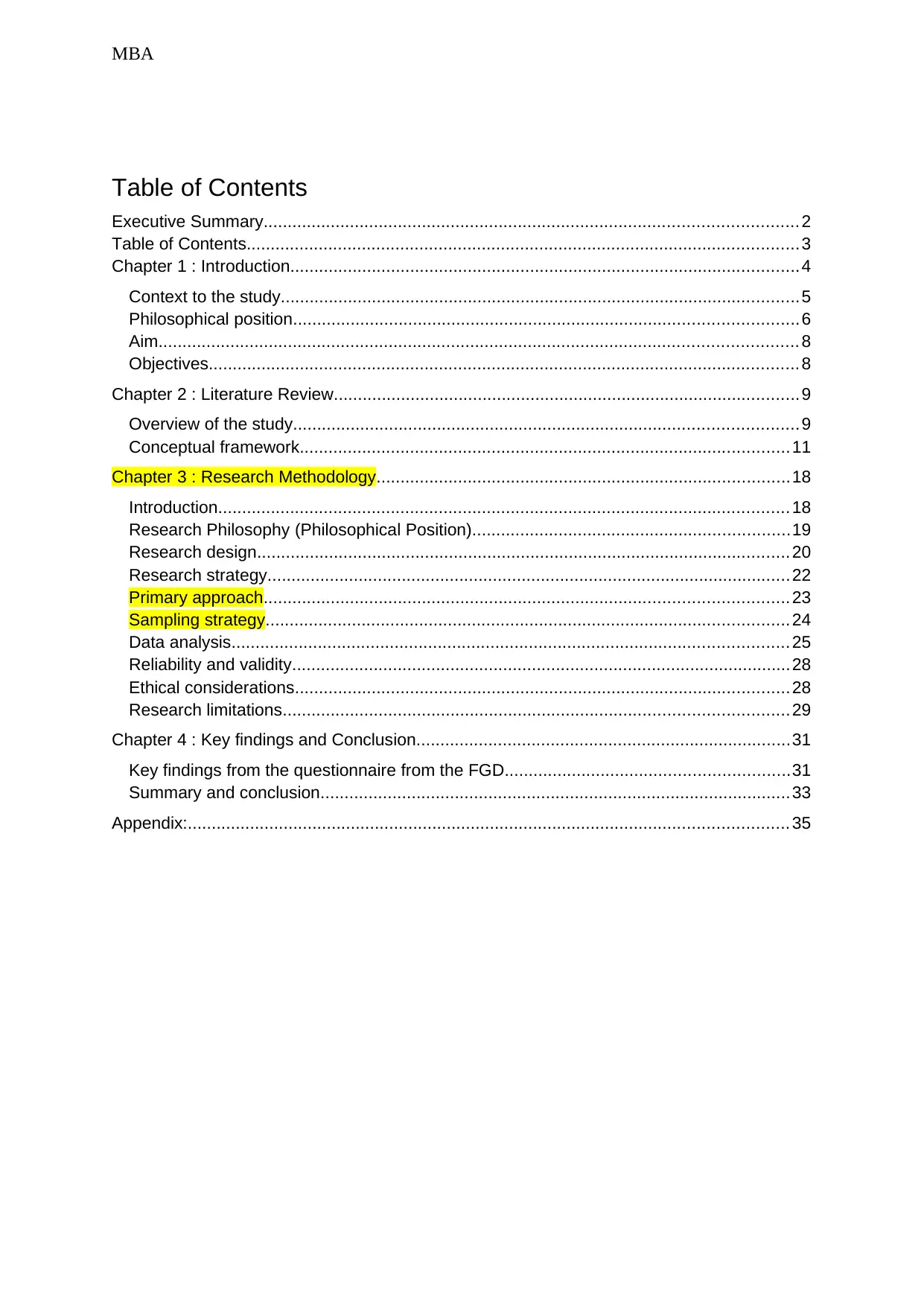
MBA
Table of Contents
Executive Summary............................................................................................................... 2
Table of Contents...................................................................................................................3
Chapter 1 : Introduction..........................................................................................................4
Context to the study............................................................................................................5
Philosophical position.........................................................................................................6
Aim..................................................................................................................................... 8
Objectives........................................................................................................................... 8
Chapter 2 : Literature Review.................................................................................................9
Overview of the study.........................................................................................................9
Conceptual framework......................................................................................................11
Chapter 3 : Research Methodology......................................................................................18
Introduction....................................................................................................................... 18
Research Philosophy (Philosophical Position)..................................................................19
Research design............................................................................................................... 20
Research strategy............................................................................................................. 22
Primary approach............................................................................................................. 23
Sampling strategy............................................................................................................. 24
Data analysis.................................................................................................................... 25
Reliability and validity........................................................................................................28
Ethical considerations.......................................................................................................28
Research limitations.........................................................................................................29
Chapter 4 : Key findings and Conclusion..............................................................................31
Key findings from the questionnaire from the FGD...........................................................31
Summary and conclusion..................................................................................................33
Appendix:............................................................................................................................. 35
Table of Contents
Executive Summary............................................................................................................... 2
Table of Contents...................................................................................................................3
Chapter 1 : Introduction..........................................................................................................4
Context to the study............................................................................................................5
Philosophical position.........................................................................................................6
Aim..................................................................................................................................... 8
Objectives........................................................................................................................... 8
Chapter 2 : Literature Review.................................................................................................9
Overview of the study.........................................................................................................9
Conceptual framework......................................................................................................11
Chapter 3 : Research Methodology......................................................................................18
Introduction....................................................................................................................... 18
Research Philosophy (Philosophical Position)..................................................................19
Research design............................................................................................................... 20
Research strategy............................................................................................................. 22
Primary approach............................................................................................................. 23
Sampling strategy............................................................................................................. 24
Data analysis.................................................................................................................... 25
Reliability and validity........................................................................................................28
Ethical considerations.......................................................................................................28
Research limitations.........................................................................................................29
Chapter 4 : Key findings and Conclusion..............................................................................31
Key findings from the questionnaire from the FGD...........................................................31
Summary and conclusion..................................................................................................33
Appendix:............................................................................................................................. 35
⊘ This is a preview!⊘
Do you want full access?
Subscribe today to unlock all pages.

Trusted by 1+ million students worldwide
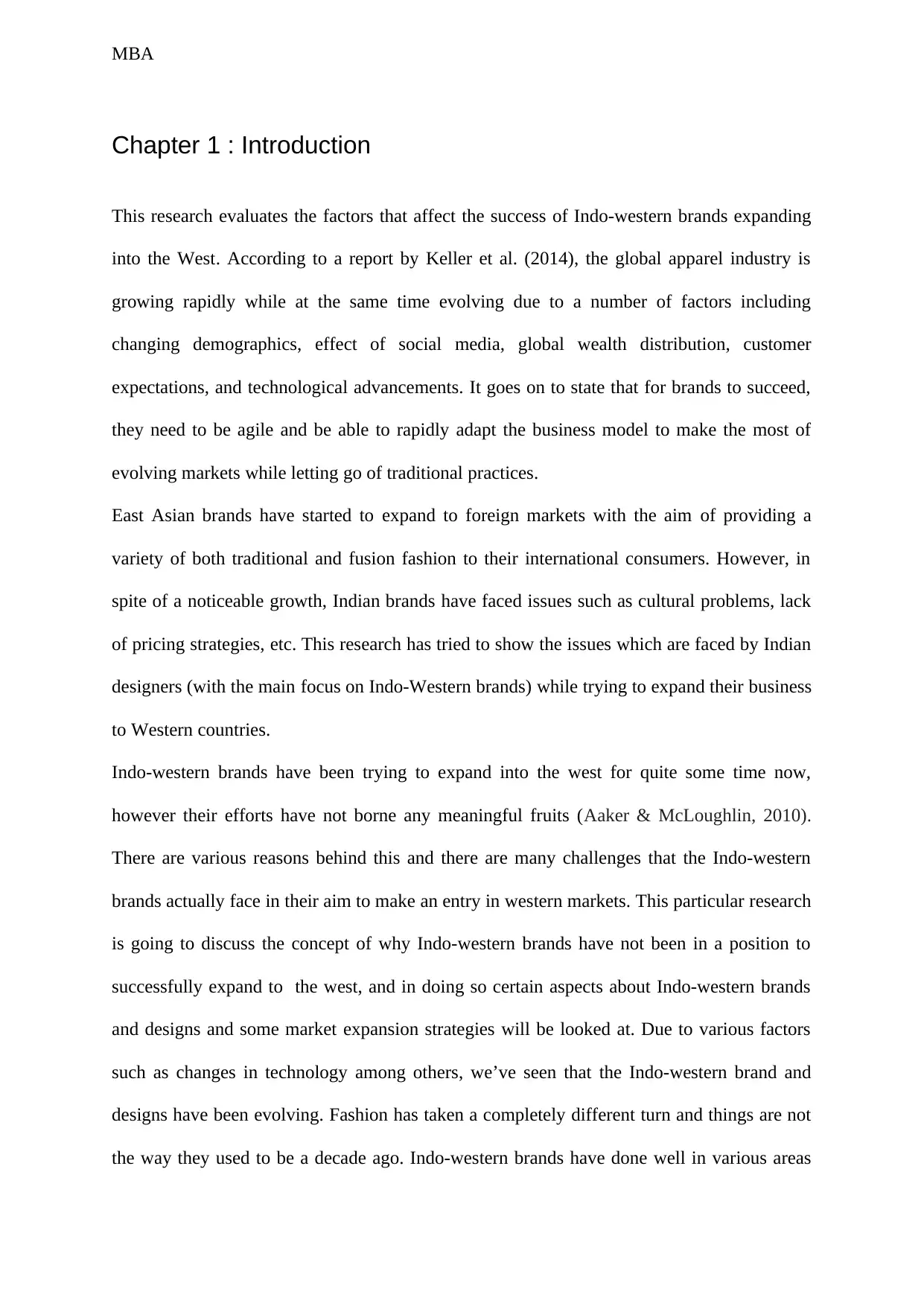
MBA
Chapter 1 : Introduction
This research evaluates the factors that affect the success of Indo-western brands expanding
into the West. According to a report by Keller et al. (2014), the global apparel industry is
growing rapidly while at the same time evolving due to a number of factors including
changing demographics, effect of social media, global wealth distribution, customer
expectations, and technological advancements. It goes on to state that for brands to succeed,
they need to be agile and be able to rapidly adapt the business model to make the most of
evolving markets while letting go of traditional practices.
East Asian brands have started to expand to foreign markets with the aim of providing a
variety of both traditional and fusion fashion to their international consumers. However, in
spite of a noticeable growth, Indian brands have faced issues such as cultural problems, lack
of pricing strategies, etc. This research has tried to show the issues which are faced by Indian
designers (with the main focus on Indo-Western brands) while trying to expand their business
to Western countries.
Indo-western brands have been trying to expand into the west for quite some time now,
however their efforts have not borne any meaningful fruits (Aaker & McLoughlin, 2010).
There are various reasons behind this and there are many challenges that the Indo-western
brands actually face in their aim to make an entry in western markets. This particular research
is going to discuss the concept of why Indo-western brands have not been in a position to
successfully expand to the west, and in doing so certain aspects about Indo-western brands
and designs and some market expansion strategies will be looked at. Due to various factors
such as changes in technology among others, we’ve seen that the Indo-western brand and
designs have been evolving. Fashion has taken a completely different turn and things are not
the way they used to be a decade ago. Indo-western brands have done well in various areas
Chapter 1 : Introduction
This research evaluates the factors that affect the success of Indo-western brands expanding
into the West. According to a report by Keller et al. (2014), the global apparel industry is
growing rapidly while at the same time evolving due to a number of factors including
changing demographics, effect of social media, global wealth distribution, customer
expectations, and technological advancements. It goes on to state that for brands to succeed,
they need to be agile and be able to rapidly adapt the business model to make the most of
evolving markets while letting go of traditional practices.
East Asian brands have started to expand to foreign markets with the aim of providing a
variety of both traditional and fusion fashion to their international consumers. However, in
spite of a noticeable growth, Indian brands have faced issues such as cultural problems, lack
of pricing strategies, etc. This research has tried to show the issues which are faced by Indian
designers (with the main focus on Indo-Western brands) while trying to expand their business
to Western countries.
Indo-western brands have been trying to expand into the west for quite some time now,
however their efforts have not borne any meaningful fruits (Aaker & McLoughlin, 2010).
There are various reasons behind this and there are many challenges that the Indo-western
brands actually face in their aim to make an entry in western markets. This particular research
is going to discuss the concept of why Indo-western brands have not been in a position to
successfully expand to the west, and in doing so certain aspects about Indo-western brands
and designs and some market expansion strategies will be looked at. Due to various factors
such as changes in technology among others, we’ve seen that the Indo-western brand and
designs have been evolving. Fashion has taken a completely different turn and things are not
the way they used to be a decade ago. Indo-western brands have done well in various areas
Paraphrase This Document
Need a fresh take? Get an instant paraphrase of this document with our AI Paraphraser
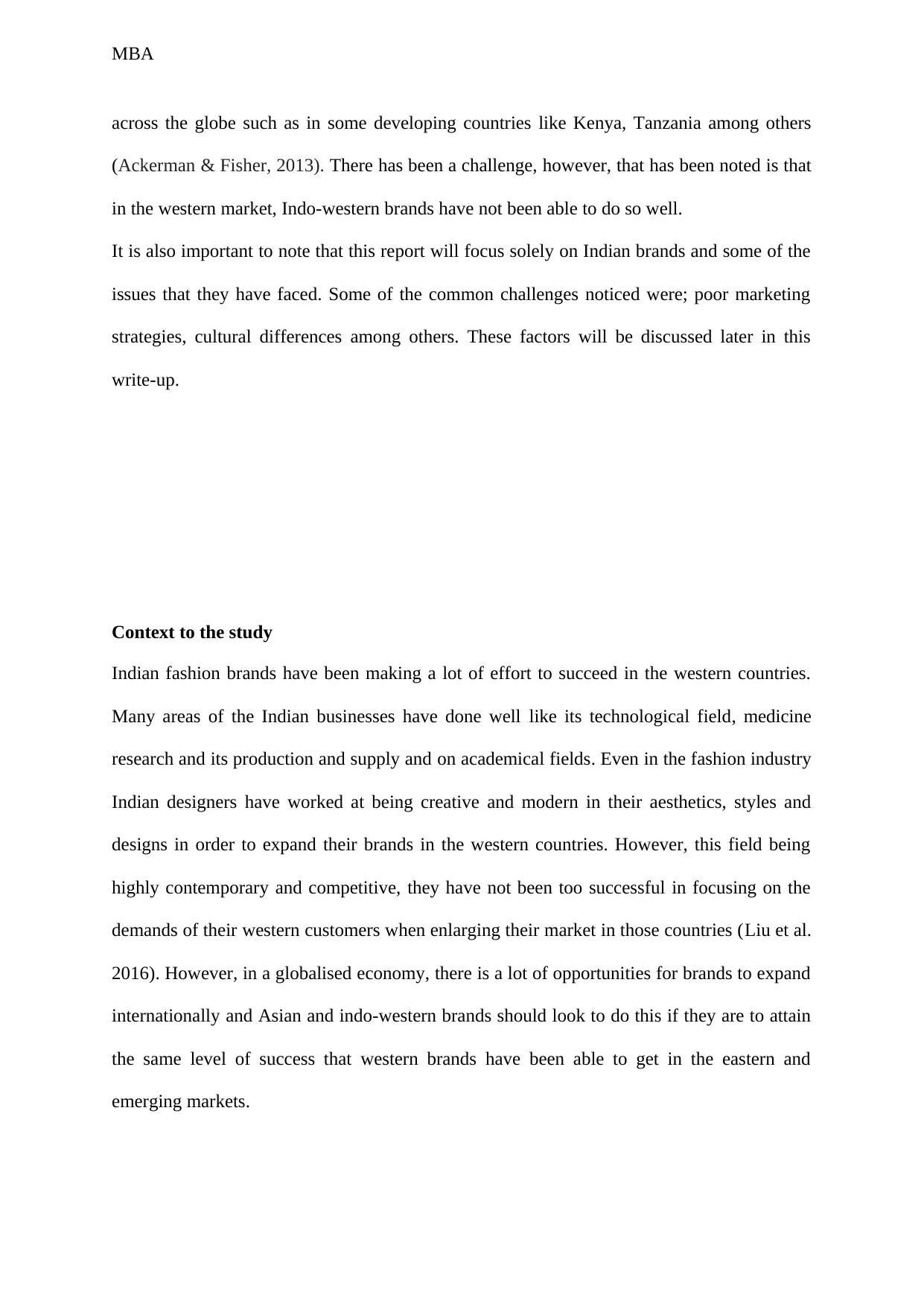
MBA
across the globe such as in some developing countries like Kenya, Tanzania among others
(Ackerman & Fisher, 2013). There has been a challenge, however, that has been noted is that
in the western market, Indo-western brands have not been able to do so well.
It is also important to note that this report will focus solely on Indian brands and some of the
issues that they have faced. Some of the common challenges noticed were; poor marketing
strategies, cultural differences among others. These factors will be discussed later in this
write-up.
Context to the study
Indian fashion brands have been making a lot of effort to succeed in the western countries.
Many areas of the Indian businesses have done well like its technological field, medicine
research and its production and supply and on academical fields. Even in the fashion industry
Indian designers have worked at being creative and modern in their aesthetics, styles and
designs in order to expand their brands in the western countries. However, this field being
highly contemporary and competitive, they have not been too successful in focusing on the
demands of their western customers when enlarging their market in those countries (Liu et al.
2016). However, in a globalised economy, there is a lot of opportunities for brands to expand
internationally and Asian and indo-western brands should look to do this if they are to attain
the same level of success that western brands have been able to get in the eastern and
emerging markets.
across the globe such as in some developing countries like Kenya, Tanzania among others
(Ackerman & Fisher, 2013). There has been a challenge, however, that has been noted is that
in the western market, Indo-western brands have not been able to do so well.
It is also important to note that this report will focus solely on Indian brands and some of the
issues that they have faced. Some of the common challenges noticed were; poor marketing
strategies, cultural differences among others. These factors will be discussed later in this
write-up.
Context to the study
Indian fashion brands have been making a lot of effort to succeed in the western countries.
Many areas of the Indian businesses have done well like its technological field, medicine
research and its production and supply and on academical fields. Even in the fashion industry
Indian designers have worked at being creative and modern in their aesthetics, styles and
designs in order to expand their brands in the western countries. However, this field being
highly contemporary and competitive, they have not been too successful in focusing on the
demands of their western customers when enlarging their market in those countries (Liu et al.
2016). However, in a globalised economy, there is a lot of opportunities for brands to expand
internationally and Asian and indo-western brands should look to do this if they are to attain
the same level of success that western brands have been able to get in the eastern and
emerging markets.
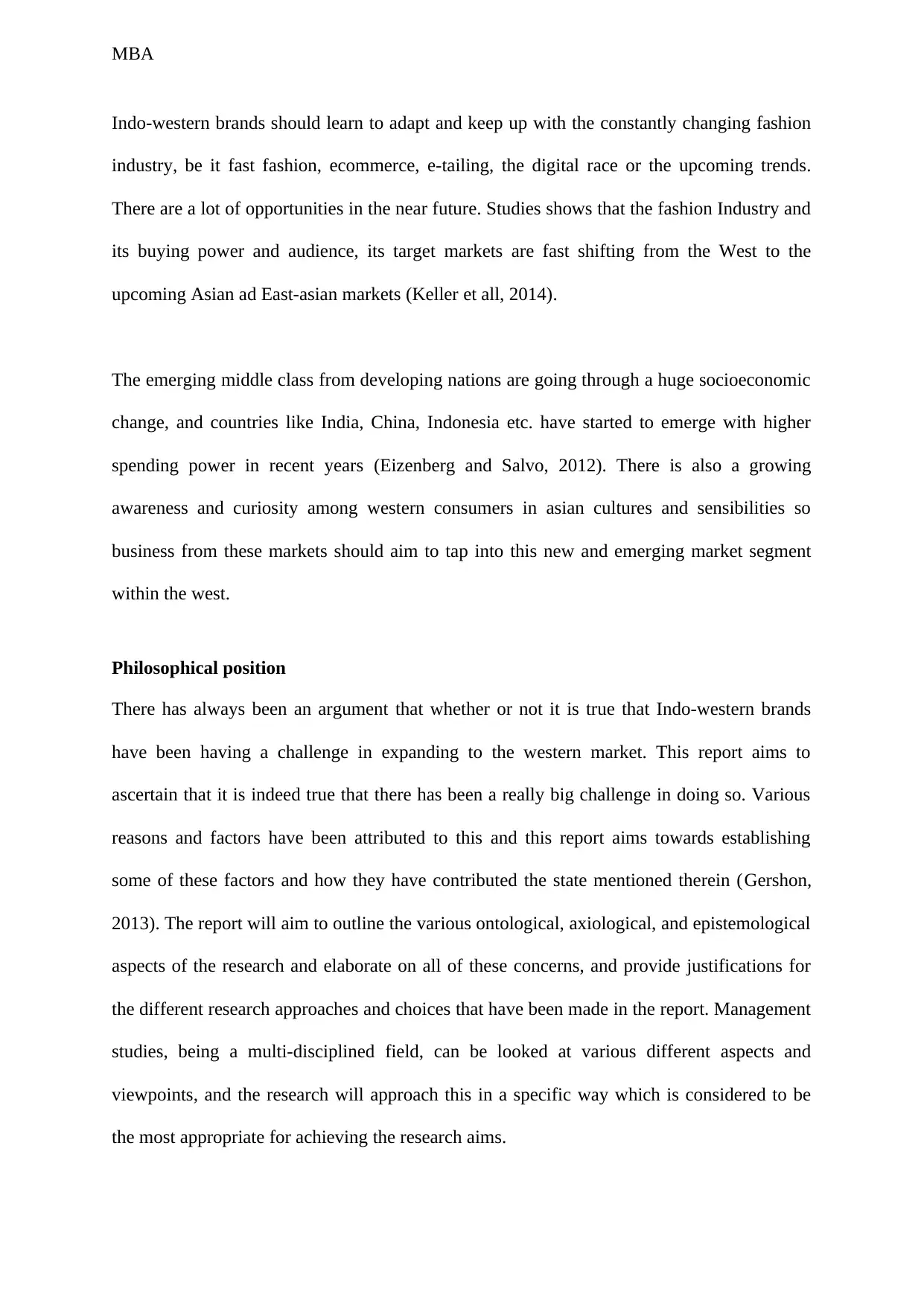
MBA
Indo-western brands should learn to adapt and keep up with the constantly changing fashion
industry, be it fast fashion, ecommerce, e-tailing, the digital race or the upcoming trends.
There are a lot of opportunities in the near future. Studies shows that the fashion Industry and
its buying power and audience, its target markets are fast shifting from the West to the
upcoming Asian ad East-asian markets (Keller et all, 2014).
The emerging middle class from developing nations are going through a huge socioeconomic
change, and countries like India, China, Indonesia etc. have started to emerge with higher
spending power in recent years (Eizenberg and Salvo, 2012). There is also a growing
awareness and curiosity among western consumers in asian cultures and sensibilities so
business from these markets should aim to tap into this new and emerging market segment
within the west.
Philosophical position
There has always been an argument that whether or not it is true that Indo-western brands
have been having a challenge in expanding to the western market. This report aims to
ascertain that it is indeed true that there has been a really big challenge in doing so. Various
reasons and factors have been attributed to this and this report aims towards establishing
some of these factors and how they have contributed the state mentioned therein (Gershon,
2013). The report will aim to outline the various ontological, axiological, and epistemological
aspects of the research and elaborate on all of these concerns, and provide justifications for
the different research approaches and choices that have been made in the report. Management
studies, being a multi-disciplined field, can be looked at various different aspects and
viewpoints, and the research will approach this in a specific way which is considered to be
the most appropriate for achieving the research aims.
Indo-western brands should learn to adapt and keep up with the constantly changing fashion
industry, be it fast fashion, ecommerce, e-tailing, the digital race or the upcoming trends.
There are a lot of opportunities in the near future. Studies shows that the fashion Industry and
its buying power and audience, its target markets are fast shifting from the West to the
upcoming Asian ad East-asian markets (Keller et all, 2014).
The emerging middle class from developing nations are going through a huge socioeconomic
change, and countries like India, China, Indonesia etc. have started to emerge with higher
spending power in recent years (Eizenberg and Salvo, 2012). There is also a growing
awareness and curiosity among western consumers in asian cultures and sensibilities so
business from these markets should aim to tap into this new and emerging market segment
within the west.
Philosophical position
There has always been an argument that whether or not it is true that Indo-western brands
have been having a challenge in expanding to the western market. This report aims to
ascertain that it is indeed true that there has been a really big challenge in doing so. Various
reasons and factors have been attributed to this and this report aims towards establishing
some of these factors and how they have contributed the state mentioned therein (Gershon,
2013). The report will aim to outline the various ontological, axiological, and epistemological
aspects of the research and elaborate on all of these concerns, and provide justifications for
the different research approaches and choices that have been made in the report. Management
studies, being a multi-disciplined field, can be looked at various different aspects and
viewpoints, and the research will approach this in a specific way which is considered to be
the most appropriate for achieving the research aims.
⊘ This is a preview!⊘
Do you want full access?
Subscribe today to unlock all pages.

Trusted by 1+ million students worldwide

MBA
A reputable research philosophy has the following characteristics as said by Saunders (2015)
- “assumptions about human knowledge (epistemological assumptions), about the realities
you encounter in your research (ontological assumptions) and the extent and ways your
own values influence your research process (axiological assumptions). These assumptions
inevitably shape how you understand your research questions, the methods you use and how
you interpret your findings”.
A reputable research philosophy has the following characteristics as said by Saunders (2015)
- “assumptions about human knowledge (epistemological assumptions), about the realities
you encounter in your research (ontological assumptions) and the extent and ways your
own values influence your research process (axiological assumptions). These assumptions
inevitably shape how you understand your research questions, the methods you use and how
you interpret your findings”.
Paraphrase This Document
Need a fresh take? Get an instant paraphrase of this document with our AI Paraphraser
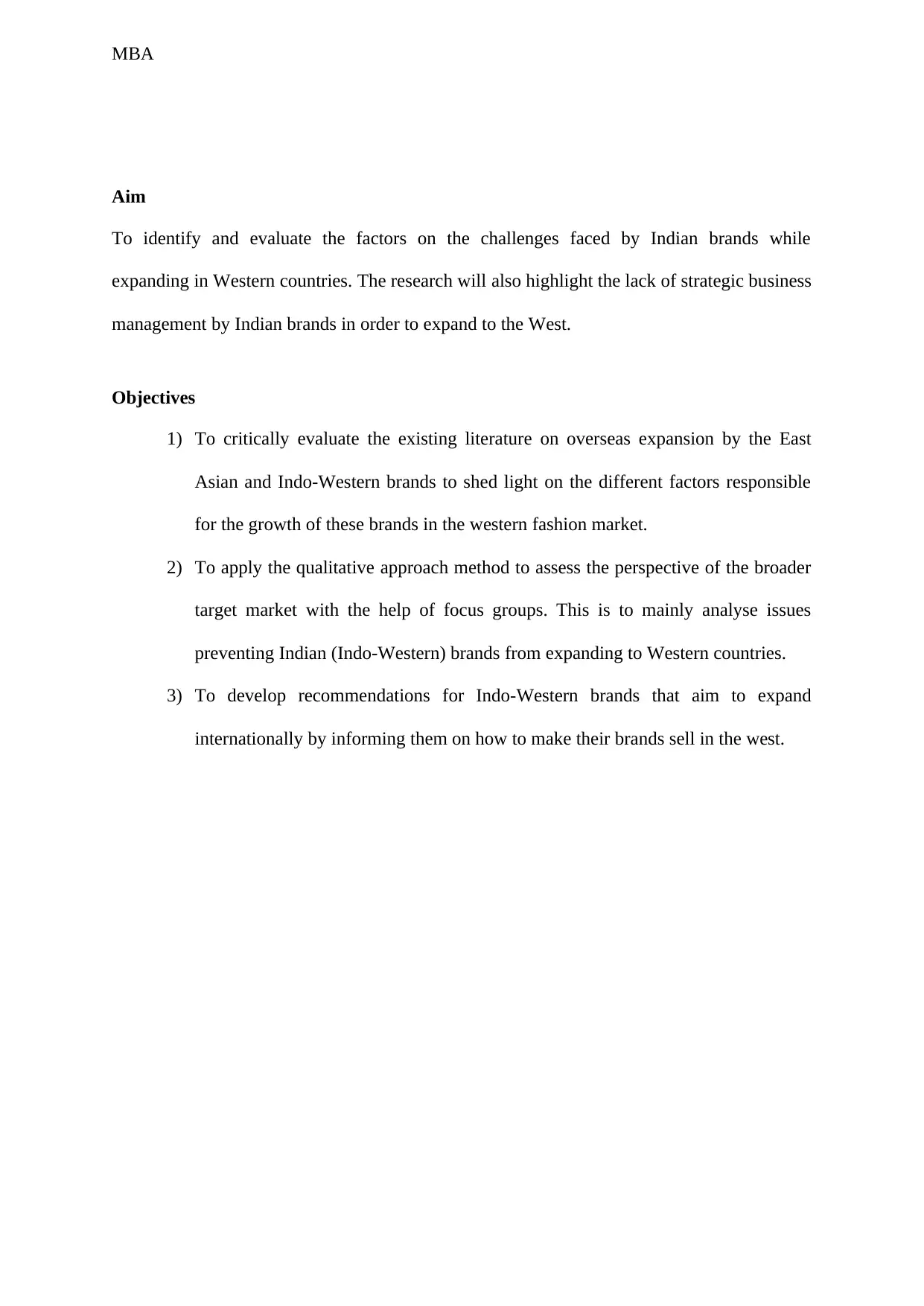
MBA
Aim
To identify and evaluate the factors on the challenges faced by Indian brands while
expanding in Western countries. The research will also highlight the lack of strategic business
management by Indian brands in order to expand to the West.
Objectives
1) To critically evaluate the existing literature on overseas expansion by the East
Asian and Indo-Western brands to shed light on the different factors responsible
for the growth of these brands in the western fashion market.
2) To apply the qualitative approach method to assess the perspective of the broader
target market with the help of focus groups. This is to mainly analyse issues
preventing Indian (Indo-Western) brands from expanding to Western countries.
3) To develop recommendations for Indo-Western brands that aim to expand
internationally by informing them on how to make their brands sell in the west.
Aim
To identify and evaluate the factors on the challenges faced by Indian brands while
expanding in Western countries. The research will also highlight the lack of strategic business
management by Indian brands in order to expand to the West.
Objectives
1) To critically evaluate the existing literature on overseas expansion by the East
Asian and Indo-Western brands to shed light on the different factors responsible
for the growth of these brands in the western fashion market.
2) To apply the qualitative approach method to assess the perspective of the broader
target market with the help of focus groups. This is to mainly analyse issues
preventing Indian (Indo-Western) brands from expanding to Western countries.
3) To develop recommendations for Indo-Western brands that aim to expand
internationally by informing them on how to make their brands sell in the west.
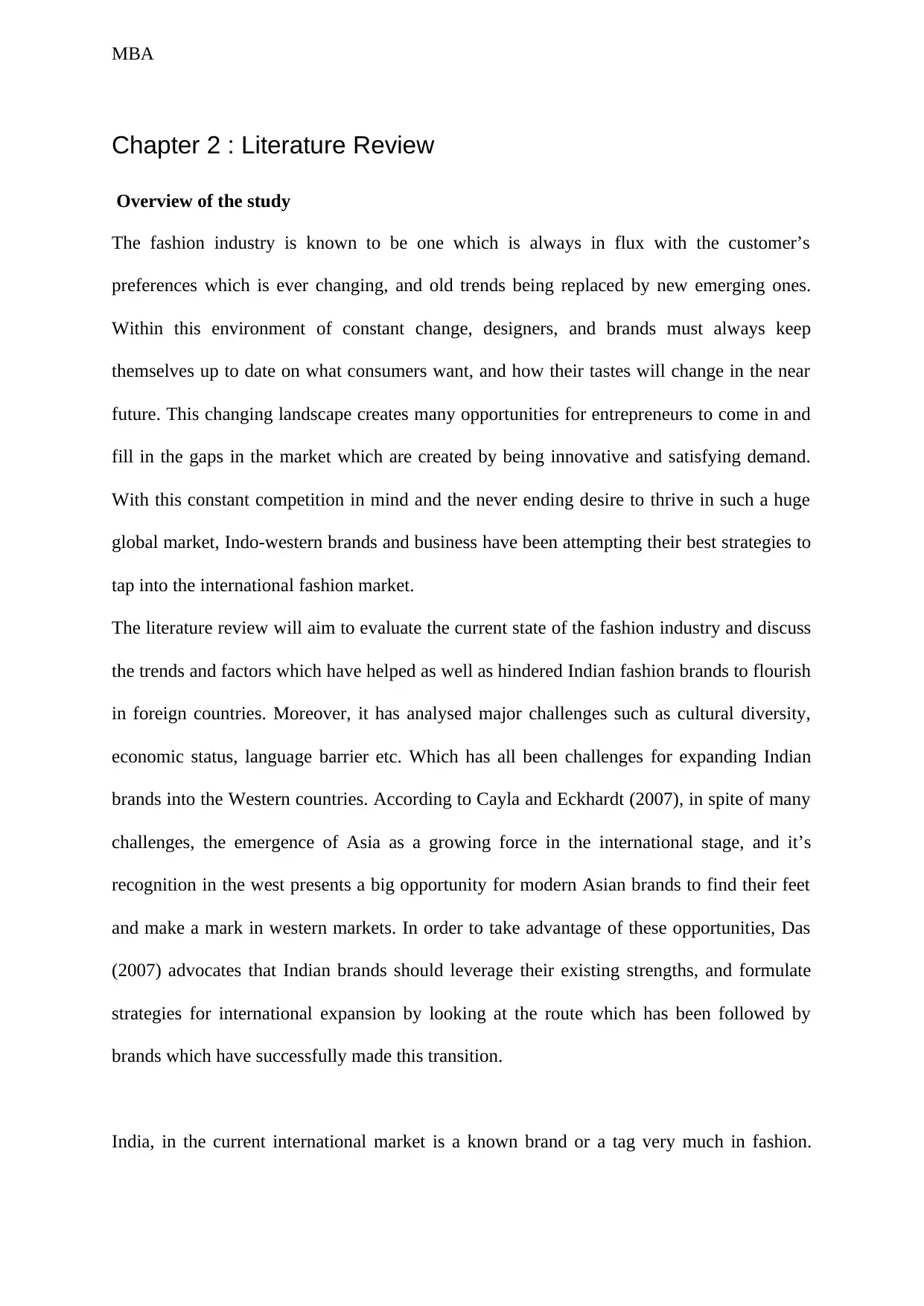
MBA
Chapter 2 : Literature Review
Overview of the study
The fashion industry is known to be one which is always in flux with the customer’s
preferences which is ever changing, and old trends being replaced by new emerging ones.
Within this environment of constant change, designers, and brands must always keep
themselves up to date on what consumers want, and how their tastes will change in the near
future. This changing landscape creates many opportunities for entrepreneurs to come in and
fill in the gaps in the market which are created by being innovative and satisfying demand.
With this constant competition in mind and the never ending desire to thrive in such a huge
global market, Indo-western brands and business have been attempting their best strategies to
tap into the international fashion market.
The literature review will aim to evaluate the current state of the fashion industry and discuss
the trends and factors which have helped as well as hindered Indian fashion brands to flourish
in foreign countries. Moreover, it has analysed major challenges such as cultural diversity,
economic status, language barrier etc. Which has all been challenges for expanding Indian
brands into the Western countries. According to Cayla and Eckhardt (2007), in spite of many
challenges, the emergence of Asia as a growing force in the international stage, and it’s
recognition in the west presents a big opportunity for modern Asian brands to find their feet
and make a mark in western markets. In order to take advantage of these opportunities, Das
(2007) advocates that Indian brands should leverage their existing strengths, and formulate
strategies for international expansion by looking at the route which has been followed by
brands which have successfully made this transition.
India, in the current international market is a known brand or a tag very much in fashion.
Chapter 2 : Literature Review
Overview of the study
The fashion industry is known to be one which is always in flux with the customer’s
preferences which is ever changing, and old trends being replaced by new emerging ones.
Within this environment of constant change, designers, and brands must always keep
themselves up to date on what consumers want, and how their tastes will change in the near
future. This changing landscape creates many opportunities for entrepreneurs to come in and
fill in the gaps in the market which are created by being innovative and satisfying demand.
With this constant competition in mind and the never ending desire to thrive in such a huge
global market, Indo-western brands and business have been attempting their best strategies to
tap into the international fashion market.
The literature review will aim to evaluate the current state of the fashion industry and discuss
the trends and factors which have helped as well as hindered Indian fashion brands to flourish
in foreign countries. Moreover, it has analysed major challenges such as cultural diversity,
economic status, language barrier etc. Which has all been challenges for expanding Indian
brands into the Western countries. According to Cayla and Eckhardt (2007), in spite of many
challenges, the emergence of Asia as a growing force in the international stage, and it’s
recognition in the west presents a big opportunity for modern Asian brands to find their feet
and make a mark in western markets. In order to take advantage of these opportunities, Das
(2007) advocates that Indian brands should leverage their existing strengths, and formulate
strategies for international expansion by looking at the route which has been followed by
brands which have successfully made this transition.
India, in the current international market is a known brand or a tag very much in fashion.
⊘ This is a preview!⊘
Do you want full access?
Subscribe today to unlock all pages.

Trusted by 1+ million students worldwide
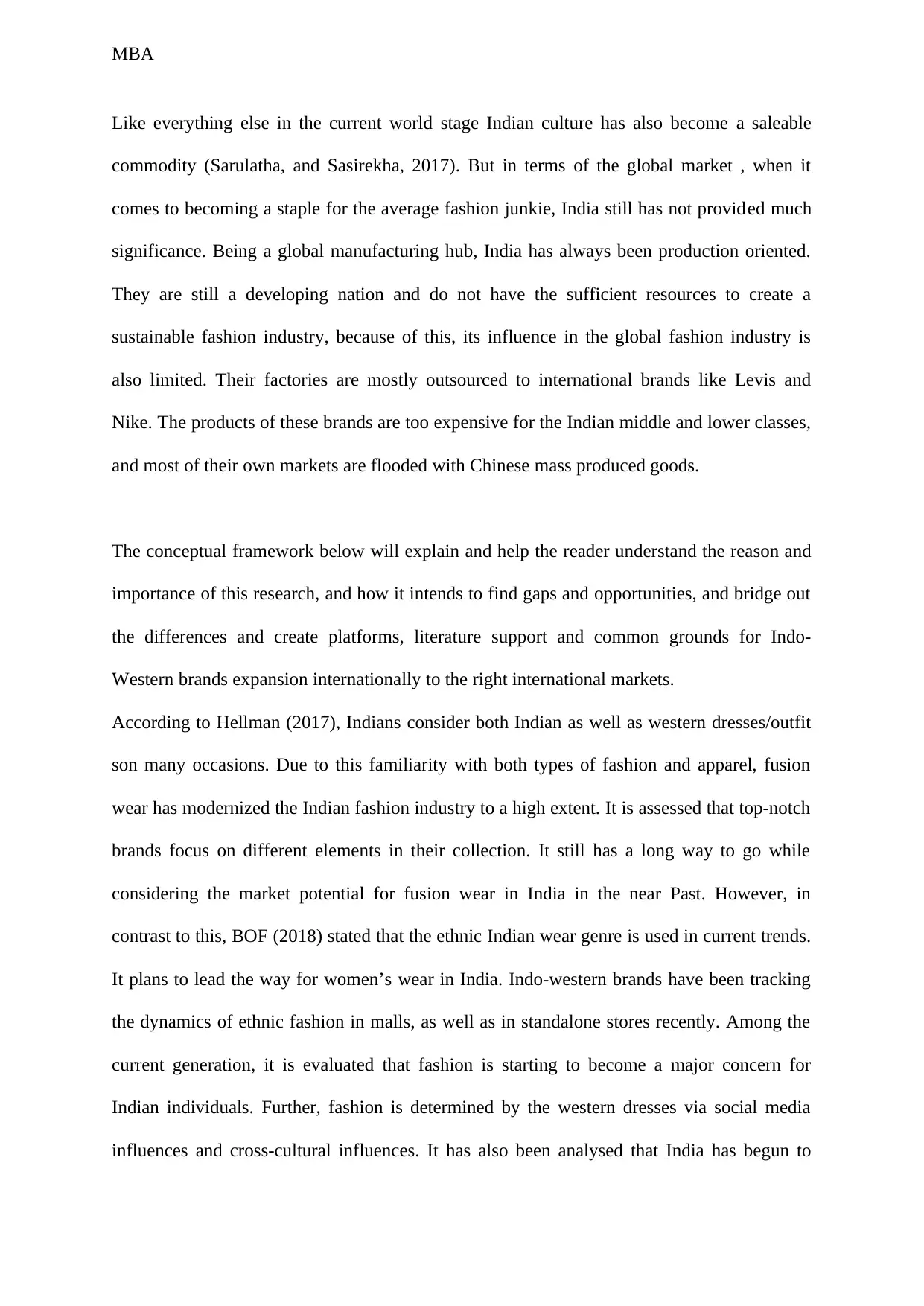
MBA
Like everything else in the current world stage Indian culture has also become a saleable
commodity (Sarulatha, and Sasirekha, 2017). But in terms of the global market , when it
comes to becoming a staple for the average fashion junkie, India still has not provided much
significance. Being a global manufacturing hub, India has always been production oriented.
They are still a developing nation and do not have the sufficient resources to create a
sustainable fashion industry, because of this, its influence in the global fashion industry is
also limited. Their factories are mostly outsourced to international brands like Levis and
Nike. The products of these brands are too expensive for the Indian middle and lower classes,
and most of their own markets are flooded with Chinese mass produced goods.
The conceptual framework below will explain and help the reader understand the reason and
importance of this research, and how it intends to find gaps and opportunities, and bridge out
the differences and create platforms, literature support and common grounds for Indo-
Western brands expansion internationally to the right international markets.
According to Hellman (2017), Indians consider both Indian as well as western dresses/outfit
son many occasions. Due to this familiarity with both types of fashion and apparel, fusion
wear has modernized the Indian fashion industry to a high extent. It is assessed that top-notch
brands focus on different elements in their collection. It still has a long way to go while
considering the market potential for fusion wear in India in the near Past. However, in
contrast to this, BOF (2018) stated that the ethnic Indian wear genre is used in current trends.
It plans to lead the way for women’s wear in India. Indo-western brands have been tracking
the dynamics of ethnic fashion in malls, as well as in standalone stores recently. Among the
current generation, it is evaluated that fashion is starting to become a major concern for
Indian individuals. Further, fashion is determined by the western dresses via social media
influences and cross-cultural influences. It has also been analysed that India has begun to
Like everything else in the current world stage Indian culture has also become a saleable
commodity (Sarulatha, and Sasirekha, 2017). But in terms of the global market , when it
comes to becoming a staple for the average fashion junkie, India still has not provided much
significance. Being a global manufacturing hub, India has always been production oriented.
They are still a developing nation and do not have the sufficient resources to create a
sustainable fashion industry, because of this, its influence in the global fashion industry is
also limited. Their factories are mostly outsourced to international brands like Levis and
Nike. The products of these brands are too expensive for the Indian middle and lower classes,
and most of their own markets are flooded with Chinese mass produced goods.
The conceptual framework below will explain and help the reader understand the reason and
importance of this research, and how it intends to find gaps and opportunities, and bridge out
the differences and create platforms, literature support and common grounds for Indo-
Western brands expansion internationally to the right international markets.
According to Hellman (2017), Indians consider both Indian as well as western dresses/outfit
son many occasions. Due to this familiarity with both types of fashion and apparel, fusion
wear has modernized the Indian fashion industry to a high extent. It is assessed that top-notch
brands focus on different elements in their collection. It still has a long way to go while
considering the market potential for fusion wear in India in the near Past. However, in
contrast to this, BOF (2018) stated that the ethnic Indian wear genre is used in current trends.
It plans to lead the way for women’s wear in India. Indo-western brands have been tracking
the dynamics of ethnic fashion in malls, as well as in standalone stores recently. Among the
current generation, it is evaluated that fashion is starting to become a major concern for
Indian individuals. Further, fashion is determined by the western dresses via social media
influences and cross-cultural influences. It has also been analysed that India has begun to
Paraphrase This Document
Need a fresh take? Get an instant paraphrase of this document with our AI Paraphraser
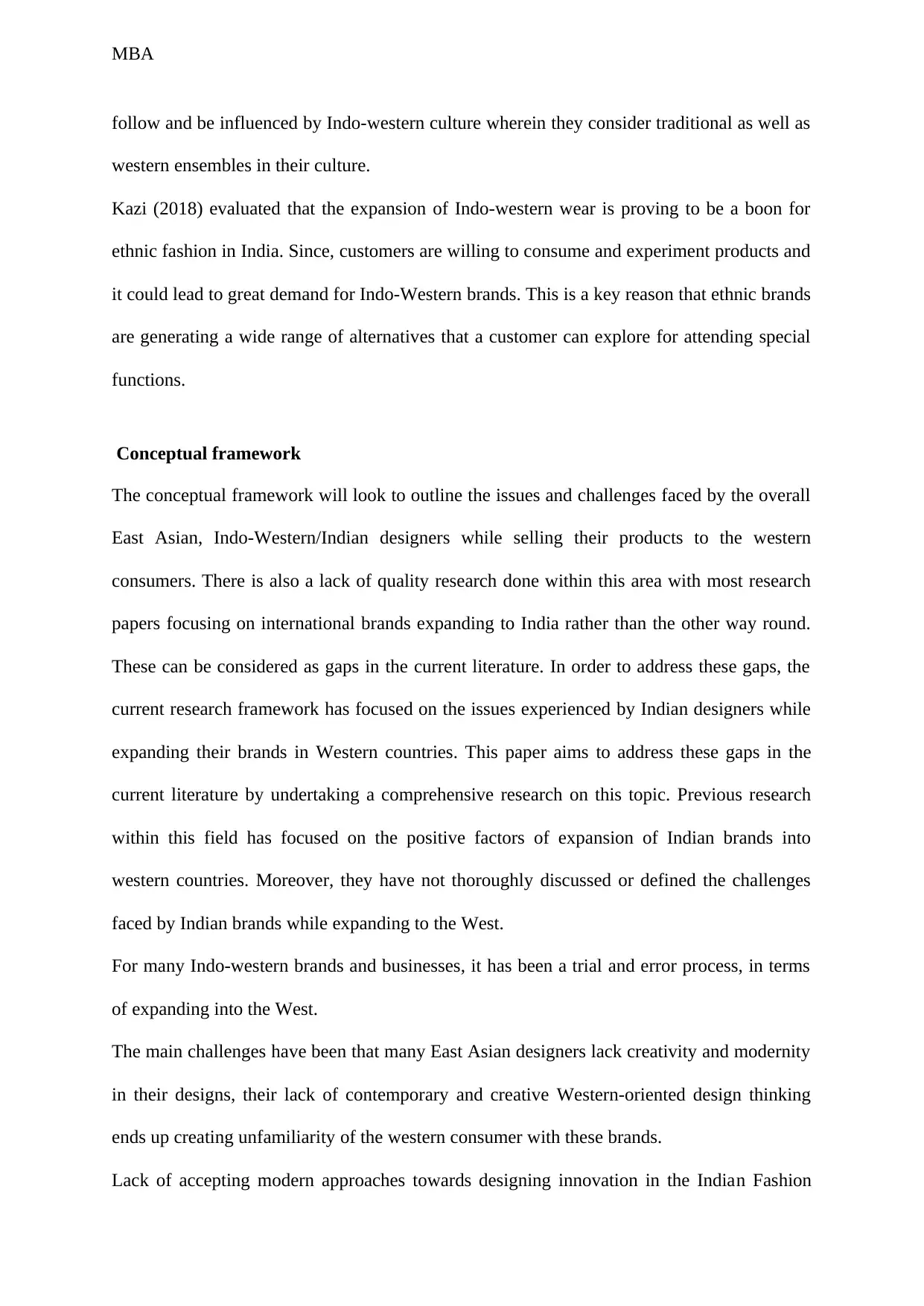
MBA
follow and be influenced by Indo-western culture wherein they consider traditional as well as
western ensembles in their culture.
Kazi (2018) evaluated that the expansion of Indo-western wear is proving to be a boon for
ethnic fashion in India. Since, customers are willing to consume and experiment products and
it could lead to great demand for Indo-Western brands. This is a key reason that ethnic brands
are generating a wide range of alternatives that a customer can explore for attending special
functions.
Conceptual framework
The conceptual framework will look to outline the issues and challenges faced by the overall
East Asian, Indo-Western/Indian designers while selling their products to the western
consumers. There is also a lack of quality research done within this area with most research
papers focusing on international brands expanding to India rather than the other way round.
These can be considered as gaps in the current literature. In order to address these gaps, the
current research framework has focused on the issues experienced by Indian designers while
expanding their brands in Western countries. This paper aims to address these gaps in the
current literature by undertaking a comprehensive research on this topic. Previous research
within this field has focused on the positive factors of expansion of Indian brands into
western countries. Moreover, they have not thoroughly discussed or defined the challenges
faced by Indian brands while expanding to the West.
For many Indo-western brands and businesses, it has been a trial and error process, in terms
of expanding into the West.
The main challenges have been that many East Asian designers lack creativity and modernity
in their designs, their lack of contemporary and creative Western-oriented design thinking
ends up creating unfamiliarity of the western consumer with these brands.
Lack of accepting modern approaches towards designing innovation in the Indian Fashion
follow and be influenced by Indo-western culture wherein they consider traditional as well as
western ensembles in their culture.
Kazi (2018) evaluated that the expansion of Indo-western wear is proving to be a boon for
ethnic fashion in India. Since, customers are willing to consume and experiment products and
it could lead to great demand for Indo-Western brands. This is a key reason that ethnic brands
are generating a wide range of alternatives that a customer can explore for attending special
functions.
Conceptual framework
The conceptual framework will look to outline the issues and challenges faced by the overall
East Asian, Indo-Western/Indian designers while selling their products to the western
consumers. There is also a lack of quality research done within this area with most research
papers focusing on international brands expanding to India rather than the other way round.
These can be considered as gaps in the current literature. In order to address these gaps, the
current research framework has focused on the issues experienced by Indian designers while
expanding their brands in Western countries. This paper aims to address these gaps in the
current literature by undertaking a comprehensive research on this topic. Previous research
within this field has focused on the positive factors of expansion of Indian brands into
western countries. Moreover, they have not thoroughly discussed or defined the challenges
faced by Indian brands while expanding to the West.
For many Indo-western brands and businesses, it has been a trial and error process, in terms
of expanding into the West.
The main challenges have been that many East Asian designers lack creativity and modernity
in their designs, their lack of contemporary and creative Western-oriented design thinking
ends up creating unfamiliarity of the western consumer with these brands.
Lack of accepting modern approaches towards designing innovation in the Indian Fashion
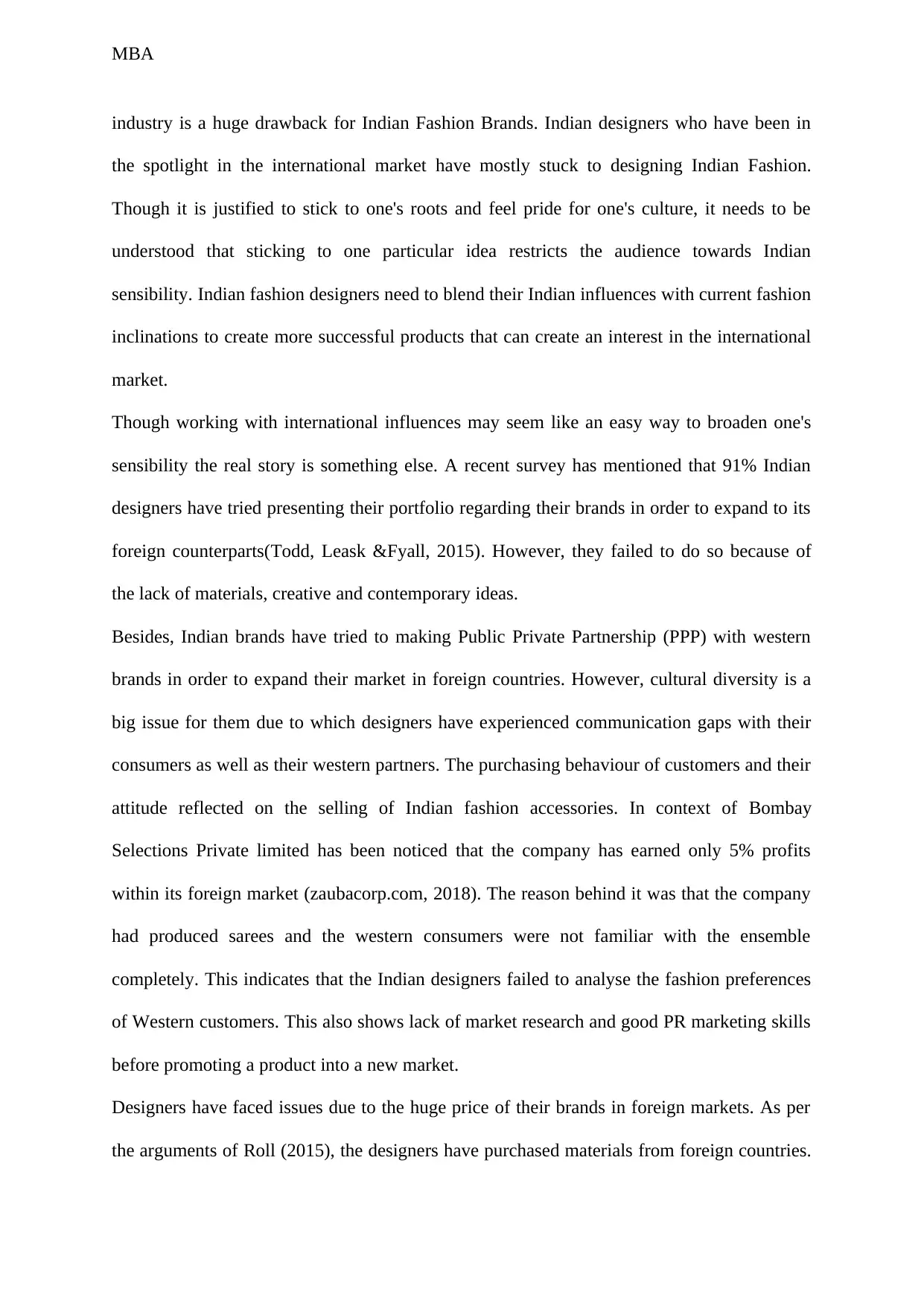
MBA
industry is a huge drawback for Indian Fashion Brands. Indian designers who have been in
the spotlight in the international market have mostly stuck to designing Indian Fashion.
Though it is justified to stick to one's roots and feel pride for one's culture, it needs to be
understood that sticking to one particular idea restricts the audience towards Indian
sensibility. Indian fashion designers need to blend their Indian influences with current fashion
inclinations to create more successful products that can create an interest in the international
market.
Though working with international influences may seem like an easy way to broaden one's
sensibility the real story is something else. A recent survey has mentioned that 91% Indian
designers have tried presenting their portfolio regarding their brands in order to expand to its
foreign counterparts(Todd, Leask &Fyall, 2015). However, they failed to do so because of
the lack of materials, creative and contemporary ideas.
Besides, Indian brands have tried to making Public Private Partnership (PPP) with western
brands in order to expand their market in foreign countries. However, cultural diversity is a
big issue for them due to which designers have experienced communication gaps with their
consumers as well as their western partners. The purchasing behaviour of customers and their
attitude reflected on the selling of Indian fashion accessories. In context of Bombay
Selections Private limited has been noticed that the company has earned only 5% profits
within its foreign market (zaubacorp.com, 2018). The reason behind it was that the company
had produced sarees and the western consumers were not familiar with the ensemble
completely. This indicates that the Indian designers failed to analyse the fashion preferences
of Western customers. This also shows lack of market research and good PR marketing skills
before promoting a product into a new market.
Designers have faced issues due to the huge price of their brands in foreign markets. As per
the arguments of Roll (2015), the designers have purchased materials from foreign countries.
industry is a huge drawback for Indian Fashion Brands. Indian designers who have been in
the spotlight in the international market have mostly stuck to designing Indian Fashion.
Though it is justified to stick to one's roots and feel pride for one's culture, it needs to be
understood that sticking to one particular idea restricts the audience towards Indian
sensibility. Indian fashion designers need to blend their Indian influences with current fashion
inclinations to create more successful products that can create an interest in the international
market.
Though working with international influences may seem like an easy way to broaden one's
sensibility the real story is something else. A recent survey has mentioned that 91% Indian
designers have tried presenting their portfolio regarding their brands in order to expand to its
foreign counterparts(Todd, Leask &Fyall, 2015). However, they failed to do so because of
the lack of materials, creative and contemporary ideas.
Besides, Indian brands have tried to making Public Private Partnership (PPP) with western
brands in order to expand their market in foreign countries. However, cultural diversity is a
big issue for them due to which designers have experienced communication gaps with their
consumers as well as their western partners. The purchasing behaviour of customers and their
attitude reflected on the selling of Indian fashion accessories. In context of Bombay
Selections Private limited has been noticed that the company has earned only 5% profits
within its foreign market (zaubacorp.com, 2018). The reason behind it was that the company
had produced sarees and the western consumers were not familiar with the ensemble
completely. This indicates that the Indian designers failed to analyse the fashion preferences
of Western customers. This also shows lack of market research and good PR marketing skills
before promoting a product into a new market.
Designers have faced issues due to the huge price of their brands in foreign markets. As per
the arguments of Roll (2015), the designers have purchased materials from foreign countries.
⊘ This is a preview!⊘
Do you want full access?
Subscribe today to unlock all pages.

Trusted by 1+ million students worldwide
1 out of 42
Related Documents
Your All-in-One AI-Powered Toolkit for Academic Success.
+13062052269
info@desklib.com
Available 24*7 on WhatsApp / Email
![[object Object]](/_next/static/media/star-bottom.7253800d.svg)
Unlock your academic potential
Copyright © 2020–2025 A2Z Services. All Rights Reserved. Developed and managed by ZUCOL.




